Kapawi
Blimey! Did you know Jon's New Zealand book Squashed Possums is out now - find out more
I can almost taste the oxygen in the air as I take a careful step in my knee-high rubber boots through the line of conga ants. Each step is accompanied by a lively slurp as the muddy juices of the jungle floor suck voraciously at my feet. I'm enjoying my walk through the rainforest. That is, until we walk through a cloud of flies. I swat them from my face but one of the little critters takes a bite me. I don't know why, but they just can't resist me.
God damn it! It hurts like hell. I'm left with a sore head and an uneasy sense of trepidation. After all, this is no walk in the park. I'm more than a little nervous about what may have bitten me and with good reason. If David Attenborough reckons that only ten percent of the world's insects have been discovered, then God alone knows what's out here.
 "How's your head," asks Hennan, our guide and translator. "Well, it's still there," I answer. The truth is though, I'm rather anxious. What if my head explodes in anaphylactic shock? Like an egg in a microwave. Maybe there's some natural remedy nearby, perhaps some nice nettle tea or a handy luminescent frog to lick. Fortunately though, as time passes, my head refuses to blow up so I relax a little and return my attention to the extraordinary world surrounding me.
"How's your head," asks Hennan, our guide and translator. "Well, it's still there," I answer. The truth is though, I'm rather anxious. What if my head explodes in anaphylactic shock? Like an egg in a microwave. Maybe there's some natural remedy nearby, perhaps some nice nettle tea or a handy luminescent frog to lick. Fortunately though, as time passes, my head refuses to blow up so I relax a little and return my attention to the extraordinary world surrounding me.
I'm a guest at an eco-tourism project called Kapawi. We're deep in the Amazon Basin in a remote corner of Ecuador, close to the Peruvian border. Surrounded by dense rainforest and jungle, we'd arrived by internal flight - which unless you fancy a very long and hazardous journey by canoe - is the only way of getting here. We'd flown from Quito, our twin prop light aircraft dropping off a precarious cliff ledge as we headed towards the piercing mountains of the Andes. "Looks like Google Earth," commented a fellow passenger as our aircraft rattled through the turbulence of a rainstorm.
We made one brief stop en-route. The town is called Shell, its airstrip decorated with a mural depicting macho soldiers toting machine guns. Today, a multinational oil company is more likely to lend its name to a prestigious photographic award, but in the 1950's this entire town was built by and named after Shell. It was intended as a foothold for oil exploration but fortunately for the rainforest, Peru invaded before drilling could begin and Shell's plans were abandoned, albeit only temporarily.
Getting here hadn't been easy, but visiting the indigenous tribes of a rainforest wasn't a decision I had taken lightly. "You know, just by visiting this place," a colleague had commented, "you'll be contributing to the destruction of their culture."
He had a good point. After all, unrestrained tourism can have a terrible affect upon a place. But this was different. The Kapawi eco-tourism project is almost unique. It was set up in 1993 by the Ecuadorian media magnate, Carlos Perez Perasso, a local version of Rupert Murdoch - but rather less of a b*stard. His aim was simple, to create an eco-tourism project in the rainforest that would sustain its local tribes and provide an alternative income to protect the land and its people from the oil industry.
The rainforest
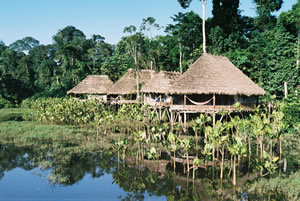 My home for the next few days is a traditional wooden house built on stilts – a 'jea'. I lounge back in my hammock, overlooking a small lake surrounded by dense rainforest. Dusk is approaching, the low mist and clouds illuminated by the last piercing shafts of sunlight creeping below the horizon. There is little to see but plenty to hear as I sit quietly for half an hour, captivated by the constant noise and chatter surrounding me.
My home for the next few days is a traditional wooden house built on stilts – a 'jea'. I lounge back in my hammock, overlooking a small lake surrounded by dense rainforest. Dusk is approaching, the low mist and clouds illuminated by the last piercing shafts of sunlight creeping below the horizon. There is little to see but plenty to hear as I sit quietly for half an hour, captivated by the constant noise and chatter surrounding me.
The rainforest has a soundtrack all of its own. A loud "Hoo! Hoo!" calls out so regularly you could set your clock by it. A cheeky "echaw" and a "chechechooo" soon follows along with a desperate and shrill "euw euw!" A roaring gale echoes through the trees - "whoo, whoo, WHOO!" What the hell was that? Whoever would have thought that a tribe of howler monkeys would make a sound like a cyclone?
"Quack!" Hang on, now that's a sound I've heard before. The familiar call of a duck seems positively surreal in this strange world. My confusion is quickly interrupted by a crash and a loud rustling sound. I like to imagine it's a cheeky monkey or a big baboon swinging across the branches but it's more likely to be the sound of the forest shedding its foliage, its nutrients eagerly consumed by the smaller plants below.
The following morning, my 6am wake up call is pre-empted by an eager "ooh-ah, ooh-ah, ooh, ooh, ooooooh!" from a lively howler monkey. Within half an hour, we're sitting in a motorised canoe, drifting along the wide expanse of the Capahuari River. Even at its most slender, the river is as wide as a three-lane motorway. The water is thick and brown. It looks like builders' tea and is similarly rich in tannin. Unlike a mug of tea though, this brown liquid conceals a submerged world of pink river dolphins and toothless piranhas (what are they going to do, suck me to death?) A white frothy foam bobs along the surface, created by decomposing vegetation. Slender tree trunks of driftwood stand upright in the water, bending in the strong current. They look like fishing rods straining to haul in their catch.
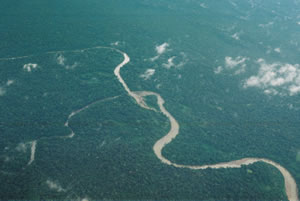 The rainforest takes some getting your head around. There is no concrete, no glass towers, no church spires, no roads, no billboards and no crowds. There are not even any fields or cultivated land. Imagine everything you know and then forget it all. If you compared the rainforest to what is familiar, you could almost be forgiven for thinking the place was empty. But of course this is far from the case. Concealed behind these dense forest walls lie a diversity of life that is incomparable anywhere else on the planet. The statistics are mind blowing, including more than a 100,000 species of plants, 562 different birds and countless other creatures.
The rainforest takes some getting your head around. There is no concrete, no glass towers, no church spires, no roads, no billboards and no crowds. There are not even any fields or cultivated land. Imagine everything you know and then forget it all. If you compared the rainforest to what is familiar, you could almost be forgiven for thinking the place was empty. But of course this is far from the case. Concealed behind these dense forest walls lie a diversity of life that is incomparable anywhere else on the planet. The statistics are mind blowing, including more than a 100,000 species of plants, 562 different birds and countless other creatures.
Stinky turkeys and licking parrots
One highlight of a visit to the rainforest is to see the 'parrot licking'. And no, you're not allowed to lick the parrots. They descend upon the clay bank, the orange cheeked parrots gnawing at the minerals to aid their digestion. The flurry of colours is spectacular and as we learnt, their personal lives are no less spirited. "The parrots, they mate for life," explained Hennan, "but when their partners are away, they cheat."
Another local celebrity is the hoatzin, aka the stinky turkey or 'kapawi' who lent his name to the tourism project. With a flutter and crash, one drops through the foliage and abruptly lands nearby with a thud on a branch overlooking the river. He has a scraggy neck and ruffled feathers. He is one ugly looking critter.
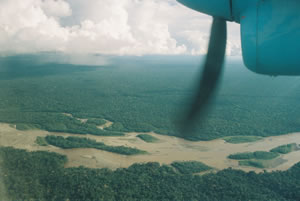 We have two guides, a local Achuar guide, Ruben, and Hennan who translates and adds his own nuggets of information. "The stinky turkey cannot fly so well," explains Hennan. "You can see they are very ugly, but their defence is their very slow digestive system. They smell so bad that predators won't go near them." The stinky turkey watched as we drifted by, secure in the knowledge he wasn't going to end up in a KFC bucket. Unfortunately for their chicks they haven't had a chance to fully develop this dubious defensive system and remain vulnerable. Instead they find safety by climbing trees using small claws on the end of their wings - an evolutionary throwback to the prehistoric era that is quite unique.
We have two guides, a local Achuar guide, Ruben, and Hennan who translates and adds his own nuggets of information. "The stinky turkey cannot fly so well," explains Hennan. "You can see they are very ugly, but their defence is their very slow digestive system. They smell so bad that predators won't go near them." The stinky turkey watched as we drifted by, secure in the knowledge he wasn't going to end up in a KFC bucket. Unfortunately for their chicks they haven't had a chance to fully develop this dubious defensive system and remain vulnerable. Instead they find safety by climbing trees using small claws on the end of their wings - an evolutionary throwback to the prehistoric era that is quite unique.
Ruben's eyesight is remarkable. He can identify the local wildlife whilst we're still squinting through a set of binoculars. We spot greater yellow headed vultures, plumbeous kites, tufted woodpeckers and white eared jacamaws - a sort of cross between a hummingbird and a kingfisher. But for impressive names, you just can't beat the violacious jay who sounds less like an exotic bird and more like some bling'ed up r'n'b star.
Whilst the birds revel in exhibitionism, the rainforests other wildlife prove rather more teasing. Monkeys scamper through the branches and we spot the occasional crocodilian caiman and sloth bear but they are shy and remain well concealed. We were lucky though and whilst drifting downriver, our motor is cut as we follow the outstretched arm of our guide, indicating a distant splash. Vanishing as quickly as they arrive, we spot the arched curves of two pink river dolphins before they submerge out of sight. "They are excited," explains Hennan, as a blowhole erupts, scattering spray into the air. "He thinks they are having relationships," we are told with a grin.
Achuar – the 'people of the palm'
Kapawi manages that most difficult of tight rope acts, balancing the demands of a profit driven tourism industry whilst protecting its land owners, the native Achuar people. Until as recently as the 1970's the Achuar had no contact with the western world and lost none of their culture. Even now, it is surprising how little has changed.
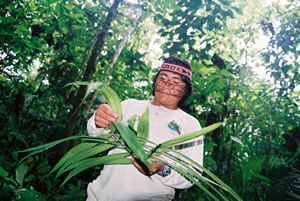 Achuar, literally means 'people of the palm', the ever present watuna palm tree that they use for oil, fruit, building their homes and making blow guns. Its leaves are used for roofing or can be stripped to produce a string like nylon. Pre-contact with the outside world, everything they had and wore was produced from this palm tree. The first thing that changed for the Achuar was abandoning making their own clothes from palm leaves. Trading for t-shirts and shorts allowed them more valuable time for hunting and gathering.
Achuar, literally means 'people of the palm', the ever present watuna palm tree that they use for oil, fruit, building their homes and making blow guns. Its leaves are used for roofing or can be stripped to produce a string like nylon. Pre-contact with the outside world, everything they had and wore was produced from this palm tree. The first thing that changed for the Achuar was abandoning making their own clothes from palm leaves. Trading for t-shirts and shorts allowed them more valuable time for hunting and gathering.
As we stumble through the trees, Ruben explains the rainforest's pharmaceutical role. All manner of ailments and diseases can be treated using the correct ingredients. For example, the native philodendron plants are used to great affect at the Kapawi lodge to deter mosquitoes, their leaves producing oily water that repels and kills the mosquitoes.
We pass young leaves of mountain garlic - used to combat flu when ingested in a tea infusion or a fiery snort up the nose. There is a heavy scent of wild cloves in the air too. Its chalky taste, Ruben advises, is good for toothache and to combat the symptoms of malaria, the Achuar have leaned to drink tea from the quinine tree.
Some of the medical practices were positively ingenious, albeit a little macabre. Ruben plucked an ant from the jungle floor. "The Achuar have learnt to use comacho ants to stitch their wounds," translates Hennan. "The ants are encouraged by the wounded Achuar to bite their torn flesh, the insect's jaws locking before tearing the ant's head from its body and stitching the wound."
It's impressive but worth remembering that the rainforest does not give up its resources easily. Until western medicine was introduced, an adult Achuar wasn't expected to live past 35 to 40 years. As soon as you were considered a bit long in the tooth (mid 30's) you'd be sent out into the rainforest equipped with some basic provisions. If you could prove your worth by surviving then you were accepted back into the village. If not, you perished. But since the arrival of the missionaries, increasingly the younger generations care and provide for their elders. In the ten years since Kapawi was established, life expectancy amongst the communities has increased by ten years thanks to western medicine and emergency services in Shell.
Drugs and God
"The rainforest is not just a drugstore," we are told, "but a warehouse and church combined."
Despite the arrival of the Catholic missionaries a generation ago, the Achuar belief system is still going strong. Ruben stands at the foot of a vast kapuk tree. "This is where the Achuar come to pray," he explains.
"When you reach adulthood at 15 years you are sent out to the jungle to make a shelter at the foot of the kapuk tree. Then, at dusk you drink the hallucinogenic plants which provoke visions and dreams."
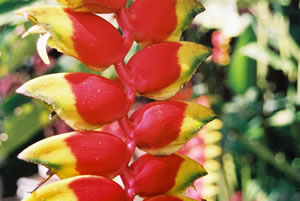 Off your face on hallucinogens in the middle of the rainforest, you must face your fears and confront your visions alone. The following day, having returned home in a weakened state, you sit down and discuss the experience with the local shaman. His role is to interpret the people and animals from your dreams. It's rather less like going to church on a Sunday and rather more like visiting a Freudian psycho-analyst.
Off your face on hallucinogens in the middle of the rainforest, you must face your fears and confront your visions alone. The following day, having returned home in a weakened state, you sit down and discuss the experience with the local shaman. His role is to interpret the people and animals from your dreams. It's rather less like going to church on a Sunday and rather more like visiting a Freudian psycho-analyst.
"So were the Achuar converted to Christianity by force?" we ask. No, we are told. Instead, most Achuar convert to Christianity voluntarily. "It might seem surprising," explains Hennan, "but Jesus and Mary sit comfortably alongside the Achuar's existing multiple spirits and gods. The Old Testament stories of Adam and Eve in the paradise of Eden are especially familiar."
Oil and the fight for survival
I stop to chat with a South African who is teaching at the local (and only) school in the Achuar province. "Today, we've been teaching the benefits of replanting and using the land sustainably," he explains. Traditionally, due to such high infant mortality rates, each family would have 10 to 12 children. Despite dramatic increases in their life expectancy, Achuar families continue to have as many children but the majority are now surviving into adulthood. Their population has almost doubled in ten years and the increased life expectancy has created an unsustainable pressure on their surrounding resources. "So why do they continue to have as many children?" I ask the teacher. "I asked the same question," he said. "They told me that the oil companies have many people, so they need lots of children to defend themselves..."
In Ecuador, all the oil and minerals below the surface of the ground belong to the state. Unsurprisingly, the country's politicians are keen to develop the rainforest and oil accounts for 40 per cent of Ecuador exports. Not only that but the trees can be logged for their timber and the land utilised for agricultural development. Unfortunately for the farmers though, there is precious little fertility in this soil, having long since been sucked dry of nutrients by the competing flora of the rainforest. Despite this, current predictions say that if current development continues unrestrained the Ecuadorian rainforest will be gone within thirty years.
What does the future hold for the Achuar? Well, despite inhabiting a precarious balance between their traditional life and the modern world, most understand that there are few alternatives. It is no longer possible to turn their backs on the developed world. Well, that's not entirely true. The Achuar's neighbours to the north – the Targaretti tribes - in the central Ecuadorian rainforest have managed to do just that. They are the last tribes in Ecuador to refuse contact with western civilisation and continue to live a traditional and nomadic way of life. It also means that their legal claim to their ancestral lands is precarious and they will have little defence against the bulldozers and oil companies who are now encroaching upon their lands.
 On our last day in the rainforest, we hike through the jungle to visit one of the communities - a collection of thatched huts next to the dry caked mud of an airstrip. It's still very unusual for an Achuar to leave the rainforest but our host had taken the unusual step of leaving his home a few years ago. Sylvayion Tick sits on a stool. He's wearing a pair of blue jeans. He keeps his head down, whittling a hand crafted comb as he speaks. His wife and young children stand behind him. Chickens run across the dirt and there is a monkey leashed to the wall, not a pet but a convenient source of protein.
On our last day in the rainforest, we hike through the jungle to visit one of the communities - a collection of thatched huts next to the dry caked mud of an airstrip. It's still very unusual for an Achuar to leave the rainforest but our host had taken the unusual step of leaving his home a few years ago. Sylvayion Tick sits on a stool. He's wearing a pair of blue jeans. He keeps his head down, whittling a hand crafted comb as he speaks. His wife and young children stand behind him. Chickens run across the dirt and there is a monkey leashed to the wall, not a pet but a convenient source of protein.
Ruben translates our host's words from Achuar into Spanish whilst Hennan translates into English. The conversation is slow and disjointed but fascinating as Sylvayion explains how he'd found employment with the oil industry near the Colombian border. As he worked, he watched as everything was razed to the ground to make way for logging and drilling. Oil slicks seeped into the water system. The animals died and a terrible sickness fell upon the local people. Helpless in the face of such unrestrained destruction, eventually the men reverted to alcoholism and the women sold themselves to the oil workers. "He returned home," translated Hennan. "He told the tribal elders what he'd seen. None of them want to see this repeated here."
The Achuar Federation are spread across a vast territorial area but they are organised. For more than a hundred years, long before the tribes ceased to be nomadic, an assembly has convened every two years to elect a new chief. Every village sends a representative to the assembly to discuss issues of importance. The rules are strict. If anyone does business with the oil companies and signs over tribal lands in exchange for cash, they are evicted from their village.
The Achuar fought a long and protracted legal battle to have their land rights recognised. If Ecuador's politicians and the oil industry thought they could easily pressure the Achuar into accepting a deal, then they seriously underestimated their opponents. Recently, Ecuador's Minister for Energy arrived here in Achuar territory. He was accompanied with armed men and came representing the Burlington oil company to make an 'offer' to buy the Achuar's land for oil development. The Achaur swiftly refused the deal and to prove their point, kidnapped the Minister for several days before returning him to Quito unharmed. The story went unreported in the national press.
Eco-tourism and the future
The fact is that the tourism project, Kapawi, may just be the only thing standing between the Achuar and the devastation of the oil industry. But despite the upbeat message in the tourist brochures, I learnt that Kapawi has not proved successful as a business and is currently failing to break even. There are 20 lodges with a total capacity of around 50 visitors, but during my stay there were only seven of us. Yet, despite this, Kapawi has succeeded as a sustainable tourist project. Of the 64 Achuar communities none use any form of money or currency in their day-to-day lives, but the company that built and runs Kapawi pays $500 per month to rent their land. This money has brought financial independence to the communities, extending and improving their lives and financially protecting them from the short-term temptations of the oil industry.
The agreement is that in 2011, the whole infrastructure of Kapawi reverts to the Achuar people. But if a professional company is failing to turn over a profit here, how on earth will the Achuar manage? How can you expect a people who were only 'discovered' thirty years ago to be expert in business management, marketing and advertising and run a successful eco-tourism business?
"The tribal leaders are keen to take over," answered Hennan, as our river boat coasted down a tributary of the Amazon. "Some think it's easy money, but it's not. Technically it is very difficult, there are very high overheads. Just importing a watermelon here increases the price from $1 to $5." Not only that but the Achuar have little concept of time keeping. No one wears a watch or has a clock. "Half of the staff at Kapawi are Achuar, but they are unreliable and arrive late for work. If they have a bad dream and the shaman advises them to stay at home, they may not arrive for work at all."
One thing is certain. Transforming the traditional survival industry of the Achuar into a modern service industry will take time. If they fail, the consequences could be devastating, but if they succeed what affect will this will have upon their traditional way of life? Sitting in a wooden hut, averting eye contact with our host – as custom demanded - Sylvayion explained how his life has changed since his father's time. "It is very similar, but not the same," he explains. "Our people used to be nomadic and there was no education, now we are settled and there is a school. Our lives are less difficult but we don't want to lose our heritage." It was clear that Sylvayion's decision not to abandon his traditional subsistence lifestyle wasn't based on any misplaced sense of nostalgia. He was under no illusions as to the alternatives and had chosen to protect his home, his family and their way of life.
In the few days I'd spent at Kapawi, I'd learnt how to extract medicine and food from the rainforest and even how to make a rather nifty bag by twining grass fibres together. I'd seen pink river dolphins, sloth bears, colourful birdlife and cheeky monkeys peering from the treetops. I'd learnt how precarious life could be, the dangers hidden in the rainforest and the consequences of losing this extraordinary place to alleged 'development'.
I had learnt so much and given so little in return. But if revenue from tourism can save places such as this, if the money isn't exploiting but serves to strengthen such cultures and their environment then perhaps going there can have a positive affect. All I can say is, if you are lucky enough to have the opportunity to visit such a place then go, before it is too late. Just don't forget your insect repellent because those little bugs will eat you alive...
Blimey! Did you know Jon's New Zealand book Squashed Possums is out now - find out more
28/02/2008
Latest articles
- Shanghai shopping
Shanghai is changing fast. - Beijing tea house scam
Getting conned, scammed and done over in Tiananmen Square - Beijing Broadcasting Corporation (BBC)
Brief introduction to Chinese television, the 'Weather Modification Office' and how China views Taiwan...